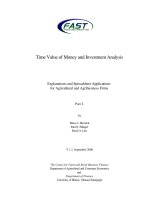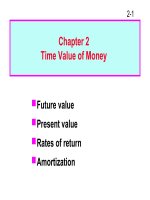Corporate finance chapter 04 time vaue of money
Bạn đang xem bản rút gọn của tài liệu. Xem và tải ngay bản đầy đủ của tài liệu tại đây (334.11 KB, 41 trang )
Chapter 4: Time Value of
Money
Objective
Explain the concept of compounding
and discounting and to provide
examples of real life
applications
1
Copyright, 2000 Prentice Hall ©Author Nick Bagley, bdellaSoft, Inc.
Value of Investing $1
– Continuing in this manner you will find that
the following amounts will be earnt:
1 Year
$1.1
2 Years
$1.21
3 Years
$1.331
4 Years
$1.4641
2
Value of $5 Invested
• More generally, with an investment of $5
at 10% we obtain
1 Year
$5*(1+0.10)
$5.5
2 years
$5.5*(1+0.10)
$6.05
3 years
$6.05*(1+0.10)
$6.655
4 Years $6.655*(1+0.10)
3
$7.3205
Future Value of a Lump Sum
FV = PV * (1 + i )
n
FV with growths from -6% to +6%
Future Value of $1000
3,500
6%
3,000
2,500
4%
2,000
1,500
2%
1,000
0%
-2%
-4%
-6%
500
0
0
2
4
6
8
4
10
Years
12
14
16
18
20
Example: Future Value of a
Lump Sum
• Your bank offers a
CD with an interest
rate of 3% for a 5
year investments.
• You wish to invest
$1,500 for 5 years,
how much will your
investment be
worth?
5
FV = PV * (1 + i )
n
= $1500 * (1 + 0.03) 5
= $1738.1111145
n
i
PV
FV
Result
5
3%
1,500
?
1738.911111
Present Value of a Lump Sum
FV = PV * (1 + i )
n
Divide both sides by (1 + i ) to obtain :
FV
−n
PV =
= FV * (1 + i )
n
(1 + i )
n
6
Example: Present Value of a
Lump Sum
• You have been
offered $40,000 for
your printing
business, payable in
2 years. Given the
risk, you require a
return of 8%. What
is the present value
of the offer?
7
FV
PV =
(1 + i ) n
40,000
=
(1 + 0.08) 2
= 34293.55281
≅ $34,293.55 today
Solving Lump Sum Cash Flow
for Interest Rate
FV = PV * (1 + i ) n
FV
= (1 + i ) n
PV
FV
n
(1 + i ) =
PV
FV
n
i=
−1
PV
8
Example: Interest Rate on a
Lump Sum Investment
• If you invest $15,000
for ten years, you
FV
n
i
=
−1
receive $30,000.
PV
What is your annual
30000
10
=
− 1 = 10 2 − 1 = 2 − 1
return?
15000
1
10
= 0.071773463
= 7.18% (to the nearest basis point)
9
Review of Logarithms
• The basic properties of logarithms that
are used by finance are:
e
= x, x > 0
ln( x )
ln(e ) = x
ln( x * y ) = ln( x) + ln( y )
x
ln( x ) = y ln( x)
y
10
Review of Logarithms
• The following properties are easy to
prove from the last ones, and are useful
in finance
ln( x / y ) = ln( x) − ln( y )
ln( x * y * z ) = ln( x) + ln( y ) + ln( z )
ln( x + y ) ≠ ln( x) * ln( y )
11
Solving Lump Sum Cash Flow
for Number of Periods
FV = PV * (1 + i ) n
FV
= (1 + i ) n
PV
FV
n
(
)
ln
=
ln
(
1
+
i
)
= n * ln (1 + i )
PV
FV
ln
PV ln ( FV ) − ln ( PV )
n=
=
ln (1 + i )
ln (1 + i )
12
Effective Annual Rates of an
APR of 18%
Annual
Percentage
rate
18
Frequency of
Annual
Compounding Effective Rate
1
18.00
18
2
18.81
18
4
19.25
18
12
19.56
18
52
19.68
18
365
19.72
13
The Frequency of
Compounding
• Note that as the frequency of
compounding increases, so does the
annual effective rate
• What occurs as the frequency of
compounding rises to infinity?
km m
EFF = Lim 1 + − 1 = e k∞ − 1
m →∞
m
14
The Frequency of
Compounding
m
k
1 + EFF = 1 + m
m
1
km
m
1+
= (1 + EFF )
m
(
)
k m = m * (1 + EFF ) − 1
1
m
15
The Frequency of
Compounding
Annual
Compounding
Effective Rate Frequency
12
1
Annual
Percentage
Rate
12.00
12
2
11.66
12
4
11.49
12
12
11.39
12
52
11.35
12
365
11.33
12
Infinity
11.33
16
Derivation of PV of Annuity
Formula: Algebra. 1 of 5
pmt
pmt
PV =
+
+
1
2
(1 + i ) (1 + i )
pmt
pmt
pmt
++
+
3
n −1
n
(1 + i )
(1 + i )
(1 + i )
17
Derivation of PV of Annuity
Formula: Algebra. 2 of 5
1
1
PV = pmt *{
+
+
1
2
(1 + i ) (1 + i )
1
1
1
++
+
}
3
n −1
n
(1 + i )
(1 + i )
(1 + i )
18
Derivation of PV of Annuity
Formula: Algebra. 3 of 5
1
1
PV * (1 + i ) = pmt * (1 + i ) *{
+
+
1
2
(1 + i ) (1 + i )
1
1
1
++
+
}
3
n −1
n
(1 + i )
(1 + i )
(1 + i )
19
Derivation of PV of Annuity
Formula: Algebra. 4 of 5
1
1
+
+
0
1
(1 + i ) ( 1 + i )
1
1
1
1
1
++
+
+[
−
]}
2
n−2
n −1
n
n
(1 + i )
(1 + i )
(1 + i )
(1 + i ) (1 + i )
1
1
= pmt *
+ pmt *{
+
0
1
(1 + i )
(1 + i )
1
1
1
1
1
+
+
+
+
}
−
pmt
(1 + i ) 2
(1 + i ) n−2 (1 + i ) n−1 (1 + i ) n
(1 + i ) n
PV * (1 + i ) = pmt *{
20
Derivation of PV of Annuity
Formula: Algebra. 5 of 5
1
1
PV * (1 + i ) = pmt *
+ PV − pmt
0
n
(1 + i )
(1 + i )
1
PV * (1 + i ) + PV = pmt − pmt
n
(1 + i )
1
pmt *{1 −
}
n
pmt
1
(
1+ i)
PV =
=
* 1 −
n
i
i (1 + i )
21
PV of Annuity Formula
pmt *{1 −
PV =
1
}
n
(1 + i )
i
pmt
1
=
* 1 −
n
i (1 + i )
22
PV Annuity Formula: Payment
PV =
pmt
1
* 1 −
n
i (1 + i )
(
pmt
−n
=
* 1 − (1 + i )
i
PV * i
pmt =
−n
1 − (1 + i )
(
23
)
)
PV Annuity Formula: Number
of Payments
(
)
pmt
−n
PV =
* 1 − (1 + i ) ;
i
(1 + i )
−n
(1 + i ) − n
PV * i
−n
= 1 − (1 + i )
pmt
PV * i
PV * i
= 1−
; − n * ln(1 + i ) = ln1 −
pmt
pmt
PV * i
ln1 −
pmt
PV * i
= 1−
; n=−
pmt
ln (1 + i )
24
Annuity Formula: PV Annuity
Due
PVdue = PVreg * (1 + i )
pmt
−n
*{1 − (1 + i ) } * (1 + i )
i
pmt
1− n
=
*{(1 + i ) − (1 + i ) }
i
=
25









